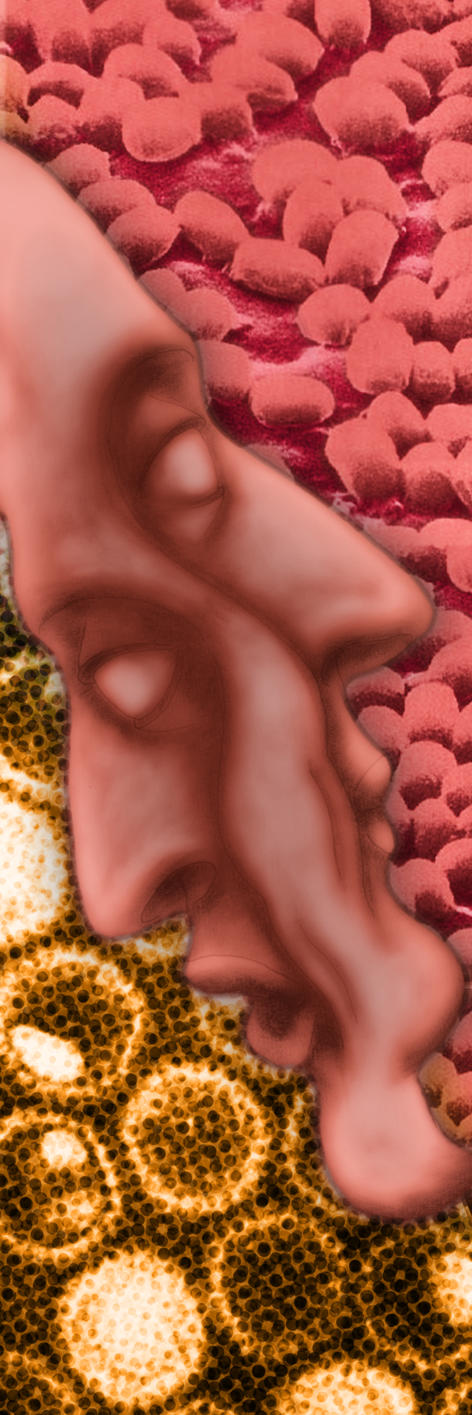Well before this age of bioterrorism, our ability to engineer increasingly lethal pathogens led to the concern that the publication of toxin gene sequences—or complete pathogen genome sequences—could be abused for the creation of bioweapons. Speaking from my experiences in this field in the 1980s and early 1990s, I think that scientists should not dismiss the potentially devastating consequences if such knowledge were to fall into the wrong hands. And if we suspect that our research could be easily abused, we should then take appropriate action—even if that means not publishing our findings.
In my view, the world has been plagued by an interpretation of freedom that is far removed from the original concept at the root of the Declaration of Human Rights. Indeed, our society tends to emphasise our rights while neglecting the responsibilities that these entail. We have replaced the democracy of the city with the democracy of the individual, which is not very far removed from the right of the strongest. And scientists—as part of society—are no exception. In the rush to publish first or to obtain grants or to see one’s name in the newspapers, many scientists do not even think about the consequences when going public with their knowledge. Such behaviour has already been criticised when cures for cancer or other diseases have been prematurely promised, but it could be devastating if it involved boasting about knowledge of some of the deadliest organisms. Here, I would like to give my personal recollections and opinion about what happened when I was working with some of these pathogens, and what I think we should learn from the ensuing events.
In 1987, researchers in my laboratory tried to clone the adenylate cyclase toxin gene of Bordetella pertussis, using both standard and state-of-the-art genetic engineering techniques. After repeated failures to clone and express the active toxin, I realised that our lack of success could be due to the fact that the toxin has to interact with a host protein, calmodulin, to be active per se.
I thought the best way to screen for the toxin gene was to combine a B. pertussis library with a vector expressing a calmodulin gene—an early ancestor of today’s double hybrid approaches. After we had made a transformable stable cya-deficient strain (TP610) (Hedegaard and Danchin, 1985), I contacted Jacques Haiech, then at Montpellier, for a calmodulin plasmid, and constructed the appropriate recipient strain TP610 pVUC1. I then asked Philippe Glaser, a PhD student in my laboratory, to construct and screen the B. pertussis library with a different antibiotic selective marker. And there they were: several beautifully red clones—being maltose positive, they were seen as red colonies in an ocean of white ones on agar plates supplemented with maltose—that we easily proved to be carrying the active adenylate cyclase (Glaser et al., 1988).
Since this toxin was known to have a similar mechanism to the Edema Factor of Bacillus anthracis, I discussed the possibility of extending this approach to the latter organism with Michele Mock. Again, we succeeded in cloning the toxin from the anthrax agent (Mock et al., 1988). And it worked both ways: I was able to show that, by using adenylate cyclase as a bait, it was possible to clone calmodulin cDNAs from mouse and human (Danchin et al., 1989).
Immediately after cloning the two toxin genes, I started thinking about the potential implications and felt rather awkward and unhappy about it. I did not know exactly what others would do with our discovery and, since I felt myself to be partly responsible for this, I started discussions about the ethical implications of such basic research. These first took place with the National Committee of the CNRS (National Centre for Scientific Research in France), where I had been nominated as a member, and then later at a Cold Spring Harbor meeting under the helm of Richard Novick, Professor of Molecular Biology and Medicine at New York University’s School of Medicine. And I came to a conclusion, which I added as a footnote to the review article I was asked to write on the three classes of adenylate cyclases we had discovered (Danchin, 1993):
‘Personal comments are unusual in scientific papers, but because B. anthracis has been assayed as a biological warfare agent, it is here to remind us that science cannot escape moral issues. A scientist must at some point become a simple ordinary citizen again, and ask himself questions, especially in the unusual situation where he can foresee some of the social or political consequences of his work. At a meeting with scientists involved in trying to improve vaccines against whooping cough, at the end of 1987, I proposed the idea to try and clone the Bordetella gene in a cya-deficient coli strain where one would have placed a plasmid expressing calmodulin. Having obtained such a plasmid, I felt uneasy after thinking about possible consequences in case we were successful: what should be done with the gene and its sequence; should it be kept secret? A discussion with colleagues, further supported by a debate at the Cold Spring Harbor Laboratory Phage Meeting in August 1988, suggested that the best thing would be to publish the sequence so that it became “common knowledge”. This was supposed to make things difficult for military use, because such knowledge would provide a basis for constructing vaccines or other antitoxin devices, whereas secrecy would not prevent military scientists from isolating the gene and constructing appropriate derivatives, against which the absence of knowledge would make any defence difficult. Was it the appropriate answer?’
To my great surprise, when I received the proofs of the article, the footnote had been removed, without any comment from the editors. I wrote it again, in red, on the proofs, insisting that it be published. It did not appear in the final article, and I never received any comment about this event. It was so unusual for a scientist to voice ethical concerns in a scientific article that it was simply not possible to have a voice at all.
In the meantime, I became aware of the programme to eradicate smallpox, and the plan to sequence the virus’s genome. Through the instigation of a debate in the French magazine La Recherche, I tried to prevent what I viewed as a criminal act. Make no mistake about it: smallpox is one of humankind’s deadliest scourges. The virus has a mortality rate of around 30% and those who survive are usually disfigured for the rest of their lives. And precisely because the World Health Organization’s vaccination programme to eradicate the virus was so successful, the virus is now deadlier and more threatening for future generations than ever before. The current bioterrorism crisis has demonstrated that no manufacturer is capable of producing sufficient amounts of new vaccines to quickly protect the population. And the old stocks are neither adequate nor is it clear whether they are still effective. Furthermore, nobody knows who else might have access to the virus in addition to the two official stocks in Atlanta, GA, and Siberia, or if someone is using the now published sequence to either resurrect smallpox or create a virus that is equally deadly.
My efforts were without success. All kinds of reasons were cited for the sequencing programme: knowledge should not and cannot be suppressed; nobody knows whether there are hidden pools of the virus; we should preserve our knowledge of biodiversity, and so on. My contention is simple: we should have destroyed the stocks of the virus, and we should not have sequenced its genome. It is a fallacy that all knowledge is good. The virus has only one host—man. It therefore cannot re-emerge and so surely it is more important to destroy it than to understand it. Equally, it is not true that sequence information will automatically lead to the development of a cure if you consider the tens of thousands of scientists who have been working for almost twenty years to find a treatment or a vaccine against AIDS. And many species become extinct every day without their genomes having been sequenced. Finally, there are more than enough current and new diseases to absorb our research efforts once we have unequivocally abolished this one.
We thought we had eradicated small-pox, but now that its sequence is on the Web, it is more of a threat than ever, freely available for anyone to download and manipulate it. And the damage has been permanently done, all because of the vanity of some irresponsible scientists. The same holds true for people, who—for their own gain—speak to journalists and explain with delectation all the horrors of bioweapons, and describe possible scenarios of a terrorist attack. I think that these people are criminals and that such talk should be considered a criminal offence. The knowledge about bioweapons is everywhere, but requiring terrorists to navigate the intricacies of scientific data is quite different from providing them with ready-to-use ideas! We should refrain from speaking about these matters, except with the appropriate representatives of the people, who may implement policies to protect our fellow citizens. And of course, we should support more work in microbiology to defeat those irresponsible persons, who condemn us to live with all kinds of plagues.
All this is easy to say, but, unfortunately, our ‘democratic’ system dictates otherwise. We will find an infinite variety of reasons to allow everybody to act as they please in the name of ‘freedom’. But this is not freedom. Freedom always entails duties and responsibilities. This means that any act must be seen in its social context—after all, we are social animals, and this is the basis of democracy—and in its biological context, because our behaviour necessarily affects all other living organisms.
But many scientists have an ego so inflated that it is simply impossible for them to think of responsibility when it is their own moment of glory and the fashion for ‘Impact Factors’ and a lot of pseudo-scientific measurement of science quality supports this attitude. If we want to fight terrorism, we first must uproot it from our own behaviour, simply by recognising that we have to share freedom, not to impose our freedom on others. This means that scientists must think of the consequences of what they are doing and, sometimes, refrain from speaking publicly or even from trying to know more. I do not believe that any God will help us or redeem us of our deeds, and so the responsibility rests entirely with us. Our knowhow is such that, if we do not adopt a more responsible attitude, we may ultimately destroy humanity. It is time to take the steps needed to construct a better future for Man and many other living species, be it at the price of ignorance.



REFERENCES
- Danchin A. (1993) Phylogeny of adenylyl cyclases. Adv. Second Messenger Phosphoprotein Res., 27, 109–162. [PubMed] [Google Scholar]
- Danchin A., Sezer, O., Glaser, P., Chalon, P. and Caput, D. (1989) Cloning and expression of mouse-brain calmodulin as an activator of Bordetella pertussis adenylate cyclase in Escherichia coli. Gene, 80, 145–149. [DOI] [PubMed] [Google Scholar]
- Glaser P., Ladant, D., Sezer, O., Pichot, F., Ullmann, A. and Danchin, A. (1988) The calmodulin-sensitive adenylate cyclase of Bordetella pertussis: cloning and expression in Escherichia coli. Mol. Microbiol., 2, 19–30. [PubMed] [Google Scholar]
- Hedegaard L. and Danchin, A. (1985) The cya gene region of Erwinia chrysanthemi B374: organisation and gene products. Mol. Gen. Genet., 201, 38–42. [Google Scholar]
- Mock M., Labruyere, E., Glaser, P., Danchin, A. and Ullmann, A. (1988) Cloning and expression of the calmodulin-sensitive Bacillus anthracis adenylate cyclase in Escherichia coli. Gene, 64, 277–284. [DOI] [PubMed] [Google Scholar]


